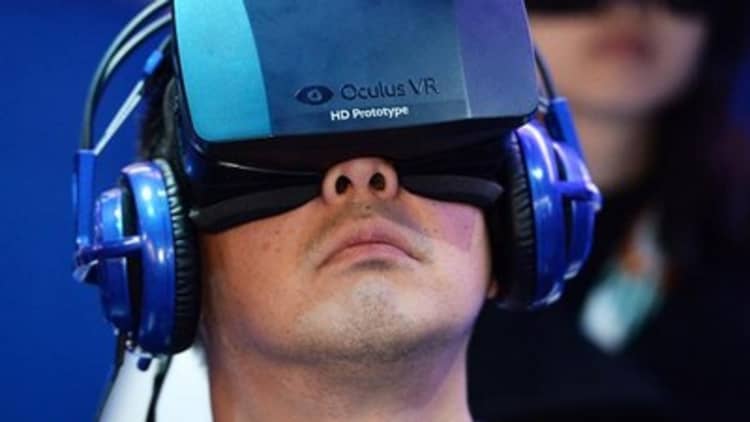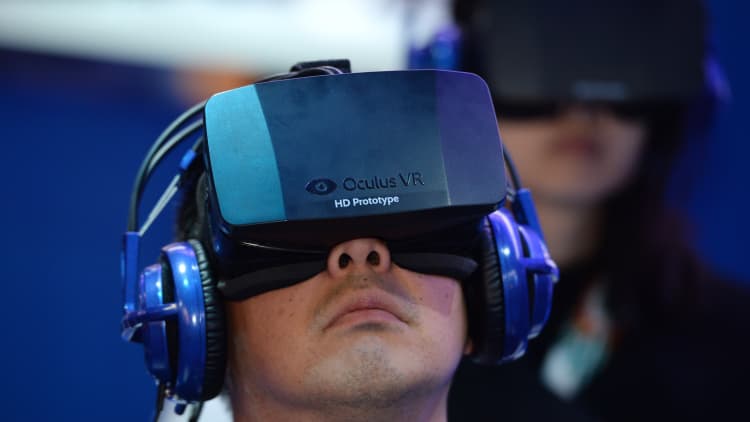
Facebook shocked the tech world last March by diving into virtual reality with the $2 billion acquisition of a niche start-up called Oculus VR. Funded initially through a 2012 Kickstarter campaign, Oculus created a slick high-end headset called the Rift that gave game developers—and Facebook founder Mark Zuckerberg—immersive viewing like nothing they'd ever experienced.
Despite the hype, consumers have yet to see a gaming device from Oculus. When they do, it will likely cost hundreds of dollars and require some technical know-how to operate.
Google, meanwhile, is sending a very different message about VR: It's ready, it's affordable and it's for everyone.
Google's product, unveiled at its developer conference in June, is called Cardboard, and it's exactly that. The concept is shockingly simple. With an Android phone and a few bucks for materials (cardboard, lenses, a magnet, a rubber band and velcro), virtual reality is available to the masses, right now.
Read MoreVirtual reality transports sports fans
"Where we are in the whole VR space, consumers need a Model T Ford, they don't need a Lamborghini," said Patrick Buckley, co-founder of DODOcase, a San Francisco-based company that got its start making iPad cases in 2010 and now sells Cardboard headsets. "There are 2 billion smartphones in the world that are basically VR devices, and consumers don't realize it."
(EMarketer predicts the number of smartphone users will climb to 2.2 billion in 2016 from 1.9 billion this year.)
There's palpable excitement brimming among a vocal VR community that's been longing for the day when passion projects could become viable businesses. From builders of stereoscopic panoramic cameras and motion controllers on the hardware side to developers of applications for virtually watching concerts, visiting museums, teaching remotely and storytelling, more techies are rallying around Google's Cardboard.
And unlike Google Glass, which never really took off and was pulled (albeit temporarily) from the consumer market last week, Cardboard is gaining steam.
Read MoreGoodbye Google Glass (for now)
To push things along, Google published the hardware specs for building a headset as well as a software development kit for app creators. The Mountain View, California-based company also readied some of its own services for VR viewing. Popular YouTube videos can be seen as if in a movie theater, Google Earth gives the feeling of flying through space and Photo Sphere lets users look at 360-degree picture streams created on their phones.
It's already gaining significant traction. In December, six months after the introduction, Google said that more than 500,000 Cardboard headsets were in users' hands.
Google, incidentally, is not the main manufacturer, leaving that task to others. DODOcase, which makes cases for mobile devices, jumped on the opportunity right away, and has sold more than 125,000 viewers at up to $25 a piece. Another, Knoxlabs, started by an entrepreneur in Los Angeles, is making similarly priced cardboard headsets, and has sold around 10,000 units. Knoxlabs also has an aluminium viewer that will go on sale for $45 this week.
Compare that to Samsung's Gear VR, which just started selling last month. The headset, with software from Oculus, costs $200 and can only be used with the Galaxy Note 4, a $700-$800 Android smartphone if purchased off-contract.
Sensing an opportunity to play to the masses, some Google employees in Paris conceived Cardboard as part of their 20 percent time—the one day a week staffers have to work on their own projects.
"There's a very low bar for people to take their Android device and unlock a new set of experiences they never had access to," said Andrew Nartker, a product manager for Cardboard. "There are new areas of interesting storytelling and development and content creation that developers can get excited about."
Read More What's next for virtual reality? Think social
Android has more than 200 VR apps in its Play Store, with some of the more popular ones easily found through the Cardboard shortcut. Jaunt, a Palo Alto, California-based developer, recorded a Paul McCartney concert in August and created an app for the song "Live and Let Die."
Imagine sitting on McCartney's piano, with his band in front of you and tens of thousands of screaming fans at San Francisco's Candlestick Park all around. Not satisfied with just putting you right next to an ex-Beatle, Jaunt also built an app that puts the viewer inside the scene of a short horror story and another that follows a World War II special operations unit.
Building an ecosystem
In downtown San Francisco, longtime game developers Drew Skillman and Patrick Hackett are hard at work on software called Tilt Brush, aimed at giving designers and artists a 3-D 360-degree virtual canvas for creating VR art and entertainment.
Tilt Brush is comparable to the tools Adobe sells to illustrators, photo editors and graphic designers, but instead of creating on a static computer screen, the artistic surface is everywhere. Skillman demonstrates the imaginative capabilities by importing a photo of Hackett and turning him into a fire-breathing devil.
The goal of Skillman & Hackett, the name of their fledgling company, is to promote an ecosystem by showing the world what's possible with virtual reality.
"As every new medium comes out, we have to recreate how to make things that look compelling without any of the tools we're used to using," said Skillman, who met Hackett at gaming studio Double Fine Productions, their previous employer. This project "is almost building itself and we're along for the ride because it's so cool."
While numerous VR apps are available on Android phones today, technical challenges stand between Cardboard as a novelty and it becoming the next big media platform. VR viewing is data heavy, which could challenge phone batteries, and the apps are big enough to clog up and slow down devices.
Read MoreSky scours Silicon Valley for virtual reality start-ups
Smartphones still don't have the horsepower and sophistication needed for the kind of user that Oculus is targeting. Positional tracking, for example, which enables the user to move any direction within the virtual world, isn't supported in Cardboard.
That leaves Skillman & Hackett in the same boat as most VR hopefuls, who are wondering how this will all play out. The market is so nascent that, aside from headset sales, there's currently very little revenue to go around. Some VR apps in the Google store cost $1 or so, but most are free.
Skillman and Hackett just want people using and testing their free product to generate some buzz and provide feedback. On Cardboard, they have an app called Tilt Brush Gallery, which at the moment is solely for viewing creations. To keep the lights on, they're doing some consulting work for companies that are getting started in VR hardware.

Jaunt is also giving away its content for now, but has plenty of cash to fund development, thanks to more than $34 million in venture financing from the likes of BSkyB, Google Ventures, Redpoint Ventures and Highland Capital.
Jaunt has 32 employees focused on two main areas. Part of the crew is out partnering with musicians and film companies to develop highly immersive content, or what CEO Jens Christensen calls "cinematic VR." The other side of the shop is manufacturing proprietary panoramic cameras. Jaunt has built or is in the process of building 16 such devices. The machine sits on a tripod and looks something like a robotic disco ball.
The company could end up in the business of leasing its cameras, and down the road it may open a Netflix-style subscription service for VR content.
"We see 2015 about creating a lot of content," said Christensen, a serial entrepreneur with a Ph.D. in computer science from Stanford University. "When somebody gets the headset, they need something to watch. We thought it would maybe be a few years before people have headsets en masse. We think now that's definitely pulled in."
Read MoreImmerse yourself in Jaunt VR
Google's entrance into the market is accelerating everything. Christensen was drawn to the business after seeing the Oculus technology, and then purchasing the Oculus DK1 (Development Kit 1) off Craigslist, the only way at the time to get one quickly. Skillman & Hackett likewise started Tilt Brush for Oculus and still see it as the probable platform of choice for the hardcore gamer.
But nobody outside of Facebook seems to know when a consumer device from Oculus will be released, especially after CES, the giant consumer electronics show, came and went with no update.
An Oculus spokesman declined to comment for this story and said in an email that the company isn't doing any interviews "outside of trade shows or events."
Even if Oculus becomes the next great gaming platform, it's unlikely to be at the expense of Google. Already, companies like HBO, Volvo and Red Bull are using Cardboard to help promote their brands, and DODOcase is partnering with several businesses to customize cheap headsets for wide distribution.
Read MoreMicrosoft & Sony: The virtual reality future
Software is being developed to run lighter VR apps in the mobile browser, and Knoxlabs, in addition to selling a variety of viewers, is working to create simple consumer applications like greeting cards and holiday cards for VR devices.
So don't be surprised if before long you attend a wedding that has Cardboard cases as party favors.
"These are going to be pervasive," said Peter Oberdorfer, president of San Francisco-based Tactic, which is building its own VR camera and also partnering with brands to help produce content. "We can provide a similar experience to what you do on one of these much more expensive and rare platforms on something that could essentially be a giveaway."
Oberdorfer, whose small team has expertise developing for gaming platforms like Microsoft Kinect, leans over a coffee table covered with multiple VR headsets, and picks up a DODOcase Cardboard viewer.
"This is how most people will be experiencing VR initially," he said.


